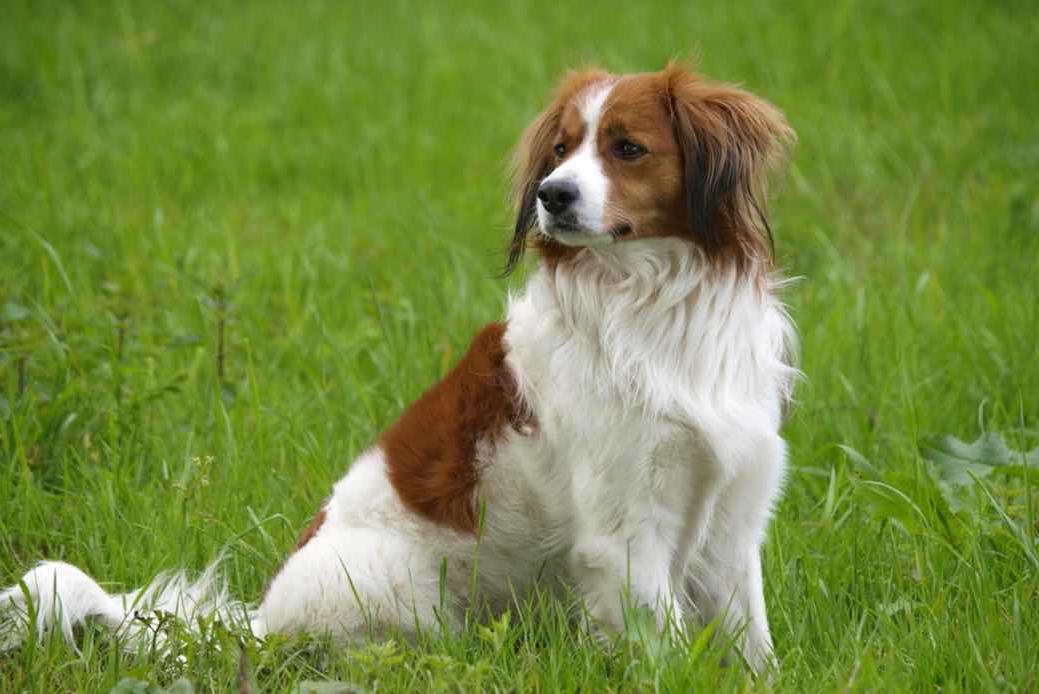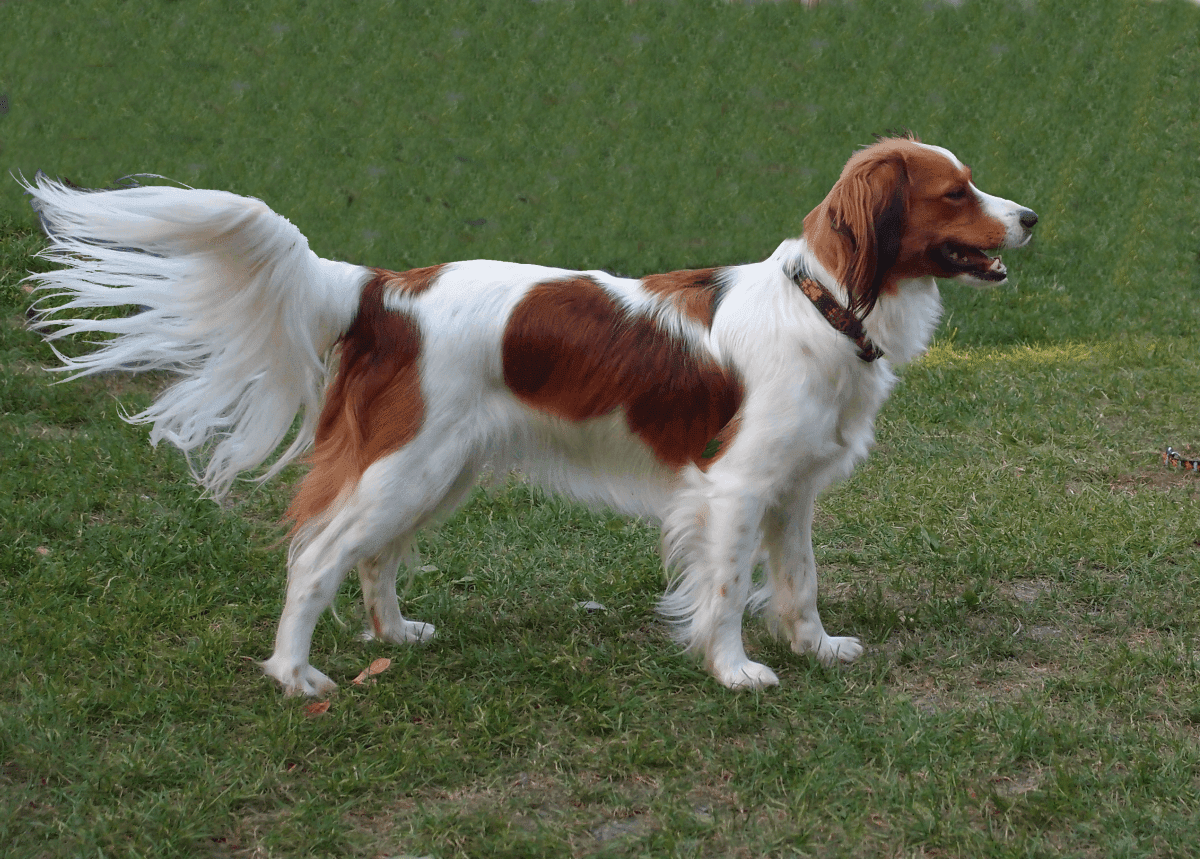- Breed Category: Sporting
- Country of Origin: Netherlands
- Average Height: Males 38-41 cm, Females 36-39 cm
- Average Weight: Males 9-11 kg, Females 8-10 kg
- Average Life Span: 12-15 years
- Grooming Requirements: Moderate, regular brushing needed
- Exercise Requirements: High, needs daily exercise
- Coat Type: Medium-length, slightly wavy
- Coat Color Variations: White with orange-red patches
- Shedding Level: Moderate
- Ear Type: Drop ears
- Tail Type: Feathered, carried high
- Temperament: Friendly, alert, intelligent
- Intelligence Level: High
- Barking Tendency: Moderate
- Compatibility with Children: Good, very friendly
- Compatibility with Other Pets: Generally good
- Training Ease: Relatively easy, eager to please
- Common Health Issues: Patellar luxation, eye disorders
- Dietary Needs: Balanced diet, watch for weight gain
- Energy Level: High
- Drooling Tendency: Low
- Sensitivity to Weather: Moderate, needs protection in cold
- Overall Maintenance Level: Moderate
- Original Purpose: Duck hunting and decoy work
- Year of Recognition by Kennel Clubs: 2018 by AKC
- Apartment Friendly: Yes, with sufficient exercise
- Best Suited For: Active families, dog sports enthusiasts
- Cost of Ownership: Moderate
- Unique Traits: Distinctive “earrings” on ears
Imagine a dog with a lively spirit, a striking orange and white coat, and a tail that dances like a feather in the breeze. This is the Kooikerhondje, a breed that’s as charming as its name is unique. Originating from the Netherlands, these dogs were once the companions of duck hunters, known for their agility and intelligence. Today, they’re cherished family pets, known for their friendly nature and playful antics.
The purpose of this article is to delve into the world of the Kooikerhondje. We’ll explore their fascinating history, distinctive characteristics, and the care they require to thrive. Whether you’re considering adding one to your family or simply curious, this guide will provide all the insights you need.
History and Origin of the Kooikerhondje

Early Development of the Kooikerhondje Breed
The Kooikerhondje has a rich history that dates back to the 16th century in the Netherlands. Originally bred as a working dog, this breed was developed to assist hunters by luring ducks into traps, a technique known as “eendenkooi.” Their distinctive orange and white coats made them easily visible in the marshes, while their playful nature helped them excel in their role.
Role in Dutch Hunting and Farming
Beyond their hunting prowess, Kooikerhondjes were also valued on farms. Their keen intelligence and agility made them excellent at controlling vermin, protecting crops and livestock. This dual role in hunting and farming cemented their place in Dutch rural life, making them indispensable companions to farmers and hunters alike.
Key Historical Figures and Events
One notable figure in the breed’s history is Baroness van Hardenbroek van Ammerstol, who played a crucial role in reviving the breed after World War II. Her dedication ensured the Kooikerhondje’s survival, leading to its recognition by various kennel clubs. This revival marked a turning point, transforming the Kooikerhondje from a working dog to a beloved family pet.
Physical Characteristics of the Kooikerhondje
Appearance
The Kooikerhondje is a medium-sized dog, typically weighing between 9 to 11 kilograms and standing about 35 to 40 centimetres tall at the shoulder. Its coat is a striking combination of orange-red patches on a white background, giving it a vibrant and eye-catching appearance. The coat is medium-length and slightly wavy, providing a soft and silky texture. One of the most distinctive features is the black-tipped ears, often referred to as “earrings,” which add a touch of elegance to their look.
Unique Physical Traits
Among the Kooikerhondje’s unique traits is its feathered tail, which is carried high and curves gracefully over its back. This tail is not just for show; it plays a role in the dog’s historical duck-luring duties. Their expressive eyes are another standout feature, often described as almond-shaped and full of intelligence and warmth. These eyes seem to communicate a range of emotions, making them particularly endearing to their human companions.
Temperament and Behaviour of the Kooikerhondje

Typical Personality Traits
The Kooikerhondje is known for its loyalty, intelligence, and playfulness. These dogs form strong bonds with their families, often becoming a devoted companion. Their intelligence makes them quick learners, eager to please, and responsive to training. Playfulness is a hallmark of their personality, making them a joy to have around, especially for those who enjoy an active lifestyle.
Suitability as a Family Pet
As a family pet, the Kooikerhondje shines. Their friendly and affectionate nature makes them great companions for both adults and children. They thrive in environments where they are included in family activities and given plenty of attention. Their moderate size and adaptable nature make them suitable for various living situations, from apartments to larger homes with yards.
Interaction with Children and Other Animals
Kooikerhondjes generally get along well with children, displaying patience and gentleness. They enjoy playtime and can be a wonderful addition to families with kids. When it comes to other animals, early socialisation is key. With proper introductions, they can coexist peacefully with other pets, although their hunting instincts may occasionally surface.
Training and Exercise Needs of the Kooikerhondje

Importance of Early Training and Socialisation
Getting a Kooikerhondje off to a good start with early training and socialisation is crucial. These dogs are intelligent and eager to learn, so introducing them to various environments, people, and other animals early on helps them grow into well-rounded adults. This early exposure can prevent behavioural issues and ensure they are comfortable in different situations.
Recommended Training Techniques for Kooikerhondjes
Positive reinforcement is the way to go with Kooikerhondjes. They respond well to praise, treats, and play as rewards for good behaviour. Consistency is key, so regular training sessions that are short and engaging work best. Avoid harsh methods, as these can lead to fear or anxiety in this sensitive breed.
Daily Exercise Requirements and Activities They Enjoy
Kooikerhondjes are active dogs that need daily exercise to stay happy and healthy. A good mix of walks, playtime, and mental stimulation is ideal. They love activities like fetch, agility courses, and even swimming. Keeping them physically and mentally engaged helps prevent boredom and the unwanted behaviours that can come with it.
Health and Lifespan of the Kooikerhondje
Common Health Issues
The Kooikerhondje is generally a healthy breed, but like all breeds, they can be prone to certain health issues. Some of the common concerns include patellar luxation, epilepsy, and hereditary necrotising myelopathy. Regular vet check-ups can help catch these issues early, ensuring your furry friend stays in top shape.
Average Lifespan and Health Tips
With proper care, a Kooikerhondje can live between 12 to 15 years. To keep them healthy, a balanced diet and regular exercise are essential. These dogs thrive on activity, so keeping them engaged with walks and playtime is crucial. Mental stimulation through training and interactive toys also contributes to their overall well-being.
Preventative Care Recommendations
- Regular vet visits for vaccinations and health screenings.
- Maintain a healthy diet to prevent obesity.
- Brush their teeth regularly to avoid dental issues.
- Check their ears and clean them to prevent infections.
- Keep their coat clean and groomed to avoid skin problems.
By following these guidelines, you can help ensure your Kooikerhondje leads a long, healthy, and happy life.
Grooming and Maintenance of the Kooikerhondje

Coat Care and Grooming Routines
The Kooikerhondje’s coat is not just beautiful; it’s also relatively easy to maintain. Regular brushing, about two to three times a week, helps keep their coat looking its best. This routine not only removes loose hair but also prevents tangles and mats, especially in the feathered areas like the tail and ears. A slicker brush or a comb works well for this task.
Shedding and Seasonal Grooming Tips
While Kooikerhondjes are moderate shedders, they do experience heavier shedding during seasonal changes, typically in spring and autumn. During these times, more frequent brushing can help manage the extra hair. Bathing should be done as needed, usually every couple of months, to keep their coat clean and healthy. Always use a dog-friendly shampoo to avoid skin irritation.
Regular grooming sessions also provide a great opportunity to check for any skin issues or parasites. Keeping their nails trimmed and ears clean is part of a comprehensive grooming routine that ensures your Kooikerhondje stays comfortable and healthy.
Diet and Nutrition for the Kooikerhondje

Nutritional Needs for Optimal Health
Feeding your Kooikerhondje a balanced diet is key to their health and happiness. These active dogs need a diet rich in high-quality proteins, healthy fats, and essential vitamins and minerals. Look for dog foods that list meat as the first ingredient and avoid those with excessive fillers or artificial additives.
Foods to Include and Avoid
Include lean meats like chicken or fish, along with vegetables and whole grains. These provide the necessary nutrients and energy for their active lifestyle. Avoid foods high in fat and sugar, as well as those containing artificial preservatives. Chocolate, onions, and grapes are toxic to dogs and should be kept out of reach.
Feeding Schedules and Portion Recommendations
Establishing a regular feeding schedule helps maintain their digestive health. Typically, two meals a day—morning and evening—work well for adult Kooikerhondjes. Puppies may require more frequent meals. Portion sizes depend on their age, weight, and activity level, so consult your vet for tailored advice. Always ensure fresh water is available.
Fun Facts and Trivia about the Kooikerhondje

Interesting Tidbits about the Breed
The Kooikerhondje is not just a pretty face; it has a fascinating history. Did you know that this breed was instrumental in the development of the Nova Scotia Duck Tolling Retriever? Their duck-luring skills were so impressive that they inspired the creation of another breed! These dogs were also featured in many Dutch paintings from the 17th century, showcasing their long-standing presence in Dutch culture.
Famous Kooikerhondjes in Media or History
While the Kooikerhondje may not be as famous as some other breeds, it has made its mark in history. One of the most notable Kooikerhondjes was Tom Poes, a beloved character in a Dutch comic strip. This character brought the breed into the spotlight, endearing it to many fans. Additionally, the breed’s revival after World War II, led by Baroness van Hardenbroek van Ammerstol, is a testament to its resilience and charm.
Final Thoughts

The Kooikerhondje is a delightful blend of charm and intelligence. This breed’s rich history and vibrant personality make it a wonderful companion for active families. While they require regular exercise and grooming, the rewards of their loyalty and playfulness are immense. Embracing a Kooikerhondje means welcoming a piece of Dutch heritage into your home, along with a devoted friend. Consider adding this spirited breed to your family for a lifetime of joy and adventure.
